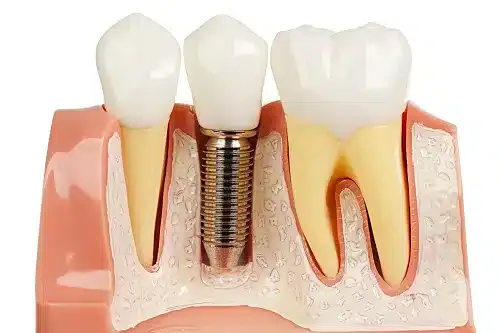Dental implants have revolutionized the field of dentistry, offering a permanent and natural-looking solution for patients with missing teeth. Implants provide a stable foundation for various dental prosthetics, enhancing both function and aesthetics. This article explores the intricacies of dental implants, the materials used in their fabrication, and the indispensable role that dental laboratories play in the precise crafting of implant-supported restorations.
Understanding Dental Implants:
- Implant Components:
- Dental implants consist of three main components: the implant fixture, abutment, and the prosthetic restoration.
- The implant fixture is surgically placed in the jawbone, serving as an artificial root for the replacement tooth.
- Osseointegration:
- The success of dental implants relies on the process of osseointegration, where the implant fixture fuses with the surrounding bone tissue.
- This integration ensures stability and durability, allowing the implant to function like a natural tooth root.
- Versatility:
- Implants can support a variety of restorations, including crowns for single-tooth replacement, bridges for multiple missing teeth, and even full arches of teeth with implant-supported dentures.
Materials Used in Implant-Supported Restorations:
- Titanium:
- Titanium is the most commonly used material for implant fixtures due to its biocompatibility and ability to osseointegrate with bone tissue.
- It provides strength, durability, and a high success rate in implant procedures.
- Zirconia:
- Zirconia is often used for the fabrication of implant-supported crowns and bridges.
- Known for its tooth-like translucency, zirconia offers excellent aesthetics, making it a popular choice for visible areas in the mouth.
- Porcelain and Metal Alloys:
- For implant-supported prosthetics, porcelain-fused-to-metal (PFM) or all-metal options may be used, especially in cases where additional strength is required.
Dental Laboratory Processes for Implant-Supported Restorations:
- Impression and Model Fabrication:
- The process begins with the receipt of an accurate impression of the patient’s mouth.
- Dental technicians use this impression to create a detailed model, which serves as the foundation for the implant-supported restoration.
- Abutment Design:
- The abutment is the connector between the implant fixture and the prosthetic restoration.
- Technicians design custom abutments that ensure a precise fit and optimal aesthetics.
- Restoration Fabrication:
- Whether it’s a crown, bridge, or denture, the dental laboratory meticulously crafts the final restoration.
- Materials such as zirconia or porcelain-fused-to-metal are chosen based on the patient’s needs and aesthetic preferences.
- Try-In and Adjustments:
- Patients undergo a try-in phase to assess the fit and aesthetics of the implant-supported restoration.
- Any necessary adjustments are made to ensure optimal comfort and functionality.
The Vital Role of Dental Laboratories:
Dental laboratories are at the forefront of implant dentistry, translating the treatment plan developed by the dentist into precision-crafted restorations. Skilled technicians with expertise in implantology collaborate closely with dental professionals to ensure that each implant-supported restoration meets the highest standards of fit, function, and aesthetics. The ability to customize restorations based on individual patient needs highlights the crucial role of dental laboratories in the success of implant procedures.
Conclusion:
Dental implants represent a transformative solution for patients seeking a permanent and natural-looking replacement for missing teeth. The meticulous craftsmanship of dental laboratories ensures that each implant-supported restoration not only functions seamlessly but also enhances the overall aesthetics of a patient’s smile. As technology advances and materials evolve, the collaboration between dental professionals and laboratories remains fundamental in achieving optimal outcomes for implant dentistry.

